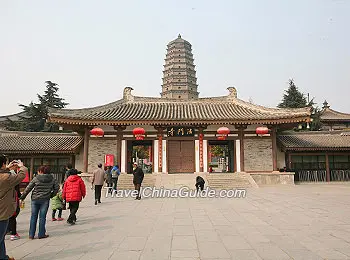Famen Temple, renowned for storing the veritable Finger Bone of the Sakyamuni Buddha, is located in Fufeng County of Shaanxi Province, 120 km (75 mi) east of Xi'an and 96 km (60 mi) west of
Baoji. With a history of over 1,700 years, it is considered the "Forerunner of the Ziggurat in Central Shaanxi." The Famen Temple Cultural Scenic Area comprises four sectors including the Temple Gate Square, Foguang Avenue, Famen Temple, and the Namaste Dagoba. The scenic area is known as the "No. 2 Cultural Symbol of Shaanxi", second only to the
Terracotta Army. It stands out as a world-class cultural scenic area featuring the "Time-honored Buddhist Holy Land and Age-old Classic Buddhist Site."
Four Gates
Between Temple Gate Square and Foguang Avenue stand four gates: Foguang Gate, Prajna Gate, Bodhi Gate and Perfect Wisdom Gate. Foguang Gate is where the light of Buddha is said to deliver all beings from torment and guide them to the Buddhist Faramita. Inside the Foguang Gate are two still water pools known as the "Heart-Pacifying Pools." As a sacred symbol of Buddhism, the lotus flower living in mud, but not stained by it, signifies the purity of Buddhists in the impure material world. Prajna refers to the great wisdom of Buddhism. The Prajna Gate means that during Buddhist medication, only by observing the guidance from prajna, can perfect wisdom and the most supreme Buddhist enlightenment be achieved. Bodhi means enlightenment and wisdom. By passing through the Bodhi, one can awaken to Buddha dharma and reach superior Buddhist thought. The architectural design of the Perfect Wisdom Gate, which consists of gateposts only, shows that the Buddha dharma is attained by observing sunyata (the nature of the void). Therefore, the Perfect Wisdom Gate is also called "Gate of Sunyata."
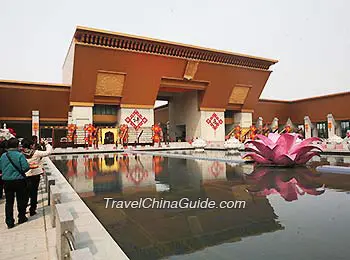 | | Prajna Gate | | 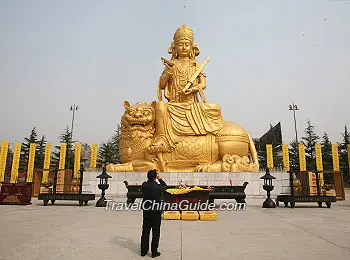 | | Buddha along Foguang Avenue | |
Foguang Avenue
Covering an area of 140,000 sq km (54,054 sq mi), Foguang Avenue is 1,230 m (1,345 yards) long and 108 m (118 yards) wide. As the main axis, it divides the Scenic Area into the Western Section and the Eastern Section. The Eastern Section, named "Famous Site of Buddha", displays the whole process from birth to nirvana of Sakyamuni. The Western Section, named "Source of Buddhist Realm", exhibits the great advance of Buddhism ever since Sakyamuni achieved nirvana. Along the Foguang Avenue are ten statues of well-known Bodhisattva.
Famen Temple
Built during the Eastern Han Dynasty to enshrine Sakyamuni's sarira, Famen Temple, which was built around the dagoba, was originally named "Asoka Temple." During the
Sui Dynasty (581-618), it was renamed "Chengshi Buddha Mandala." In the
Tang Dynasty (618-907), it was given its present name. Later, by holding several ceremonies enshrining the relic of Sakyamuni's finger bone, it became world-famous. The most representative structures here are the Famen Temple Pagoda and Famen Temple Museum.
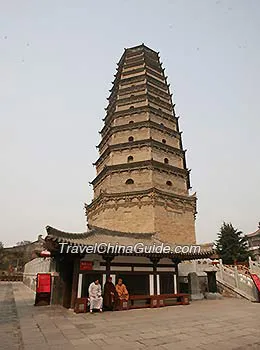 | | Famen Temple | | 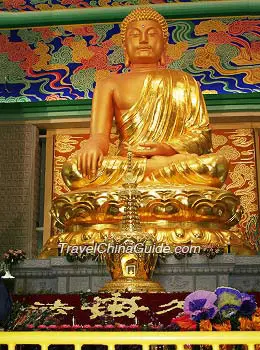 | | Buddha Enshrined in the Temple | |
At its center is 13-tiered octagonal pagoda under which, it is said, a sliver of the finger bone of Sakyamuni was discovered. In 1981, it was found that the pagoda was gradually sinking into the ground. This led to reconstruction, during which, in 1987, an Underground Palace was unearthed. At present, this is the largest Buddhist underground palace discovered so far. Many royal treasures and jewelry were found here – more than 2,000 pieces surrounded the Tang mandala (geometric designs, usually circular, symbolizing the universe). The most precious item was the veritable Finger Bone of the Sakyamuni Buddha.Judging from the grand architectural style, the Underground Palace is thought to have been established during the Tang Dynasty. But why were such precious treasures stored under the pagoda? Tracing back to a high point in Chinese history, Famen Temple was the royal temple during the Sui and Tang Dynasties. Emperors during the Sui and Tang believed that enshrining and worshiping the bone of Sakyamuni would bring riches and peace to the land and its people. So an offering of treasure was made to the finger bone and it was housed in the Underground Palace.
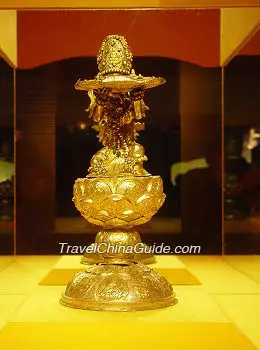 | 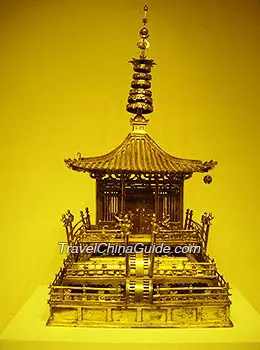 |
Famen Temple Museum was established in 1987 and includes most of the precious treasures from the Tang Dynasty removed from Underground Palace. Gold and silverware, colored glaze ware, porcelain and silks are all on display. Due to its popularity with tourists and their curiosity about the relics, two new exhibition halls were established in 2000. The exhibition area has been expanded from 500 square meters (598 sq yd) to 3,000 square meters (3,588 sq yd).
Namaste Dagoba
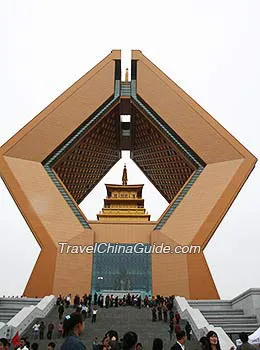 |
| Namaste Dagoba |
Namaste Dagoba was completed on May 9, 2009 after the construction of 3 years. The Namaste Dagoba is used to enshrine the only relic of Sakyamuni's finger bone in the world. The full height of the dagoba is 148 m (162 yd). The numbers "148" were chosen because "1" symbolizes that the Buddha does not differ from all other beings. The Buddha is only the awakened being while other beings are yet to be enlightened. The "4" and "8" denote the 8th day of the 4th lunar month, the birthday of Buddha. The architectural design of Namaste Dagoba represents the Buddhist thought of unification, concord harmony and peace. The one and only relic of Sakyamuni's finger bone in the world was enshrined in the underground palace in the Namaste Dagoba. The finger bone is brought up to the first floor at the Namaste Dagoba on the 1st day and 15th day of each lunar month plus Saturdays and Sundays for tourists and devotees to pay homage.
How to Get to Famen Temple
Depart from Xi'an:
1. Take the direct tourist bus from Xi'an West Bus Station at 09:00 and 16:30.
2. Take a long-distance bus bound for Fufeng County at Xi'an Coach Station (on the south of Xi'an Railway Station) and then take a taxi to Famen Temple in around 15 minutes at the cost of about CNY 20.
Xi'an Bus / Metro Search.
Depart from Baoji:
Take a long-distance bus bound for Fufeng County at Baoji Bus Station, then take a taxi to Famen Temple.
| Ticket | March to November: CNY 100
December to next February: CNY 90
Children under 1.2 m (3.9 ft): Free |
| Opening Hours | 8:30 - 17:00 (stop admission at 16:30) |
Recommended
time for a visit | 3 hours |
- Last updated on Aug. 15, 2024 by Catherine He -
